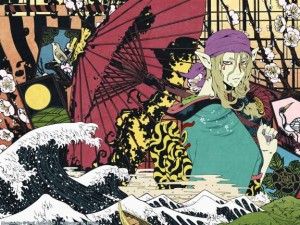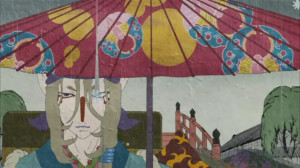 The time has finally come for me to attempt to review a series that I can find zero fault with, a series which is pure perfection. I touched upon it briefly, months ago, in my post “It’s Pretty – And Deadly: Horror Animanga.” But it’s finally time for a full review of Toei Animation’s Mononoke.
The time has finally come for me to attempt to review a series that I can find zero fault with, a series which is pure perfection. I touched upon it briefly, months ago, in my post “It’s Pretty – And Deadly: Horror Animanga.” But it’s finally time for a full review of Toei Animation’s Mononoke.
Released in 2007, Mononoke is a spin-off of the previous year’s horror title, Ayakashi. Both titles are Japanese words for “spirits” or supernatural beings of one kind or another that should not exist within the mortal world. The premise in Mononoke is that the only recurring character, simply referred to as the Medicine Seller throughout all twelve episodes, wanders about Edo Japan exorcising all of the mononoke that he encounters. Stated in that way, it sounds simple enough; however, in order to demolish the restless spirits, he needs to figure out how they came into being; he needs to find their Form, their Truth, and their Regret.
The Medicine Seller himself, though technically the protagonist by default, remains a mysterious character. Despite his static nature, he is compelling and complex, and even other characters in the series constantly question whether he might not have some illegitimate claim to this world himself. But as he assures everyone constantly, he is simply a Medicine Seller, and therefore of the lowest class in Edo-period Japan (lower even than the working class; the samurai were the highest class, and the only ones allowed to carry a sword – which the Medicine Seller also does).

Mononoke draws very heavily from traditional Japanese culture, to its immense advantage. Taking the Edo period setting to its furthest potential, the animators have chosen to render the entire show in flat color with various traditional textile prints and age-old symbols, giving the audience a bright, complex treat for the eyes. In addition to this, the music is drawn from the period, with taiko drums signalling major events. Though every episode has a short explanation at the end for non-Japanese viewers, there is likely a huge amount of cultural nuance that would go over anyone’s head who has not been brought up in the culture.
But most of all, the ghosts, demons, spirits, creatures that are encountered…they are the most Japanese aspect of this series, and their presence and import is highlighted and accentuated by the other details. Demon children, fish monsters on ghost ships, a mononoke who hides his identity behind a Noh mask, haunted incense, and a wronged woman come back as a cat-ghost: These are the monsters born of long-running Japanese occult myths, and the Medicine Seller walks the fine line between their inherent horror and what we know of as reality.
And the horror is very, very real. Despite its exquisite beauty, Mononoke should not be written off as an easy watch. Japanese ghosts are not keen to merely rattle their chains; these hauntings result in multiple deaths per episode, with a grotesquely beautiful arrangement of bloody violence. Mononoke is a great blend of the stereotypically Japanese aesthetics of quiet simplicity and subversive gore/psychological horror. The body count, coupled with the rich visual texture, create a series that is somewhat difficult to take in more than two episodes at a time.
Mononoke is a true experience of the senses, and a must-watch for artists, animation enthusiasts, horror buffs, history geeks, and anyone who simply loves a good story. But perhaps, because it is so reliant on visuals, the best thing to do would be to show you the trailer. Happy viewing, fellow fans!











1 Comment